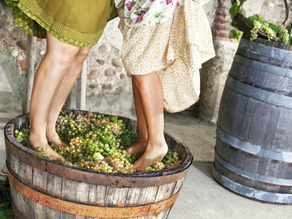Bob's Blog #6 -A Californian’s Perspective on the History of New Mexico Wines
- Robert Dolci
- Aug 9, 2020
- 4 min read
Most of you that are members of the Northern Rio Grande Chapter of New Mexico’s Vine and Wine Society know that I spent most of my adult life in California’s Silicon Valley. What I know about wine came out of a bottle from either Napa Valley or Sonoma County. Just about the only wine I drank from my mid 20s until my mid 60s was wines from Northern California. Why not, it was really good stuff. In 2012 Wendy and I moved to New Mexico. In 2013 we joined the Vine and Wine society. That was our first exposure to New Mexico wine. Our first New Mexico wine came from Black Mesa Vineyards. It was enjoyable. It was even good enough for us to make a trip to the winery and purchase a few bottles.
Did you know that New Mexico wines predate California wines? Of course you didn’t. But it did. As it did in New Mexico, the history of wine in California began with the settlement of the Spanish. Vineyard planting in California began with the Spanish Franciscan Missionaries starting with California's first mission, Mission San Diego de Alcalá in 1769.
Because of a Spanish economic law that prohibited Spanish grape vines from leaving Spain, two Franciscan monks in 1629 ignoring the law smuggled vine cuttings out of Spain into what is now New Mexico. Fray García de Zúñiga, a Franciscan, and Antonio de Arteaga, a Capuchín monk, planted the first vines at Pueblo Piro. The pueblo was located just south of modern-day Socorro. New Mexicans were making wine 140 years before Californians.
The vine cuttings smuggled by the monks were a Vitis Vinifera grape variety commonly known as the Mission grape. Somewhat surprisingly, this variety is still grown in New Mexico today. Why would you or anyone else for that matter be surprised at that, you ask? Read on if you are so inclined.
From here on out, rather than say “what is now New Mexico” or “the Territory of New Mexico” or even “Nuevo México”, I’ll just say New Mexico.
Between 1633 and 1800 there were numerous events that took place in New Mexico that had significant adverse impact on its wine industry. There were a series of pueblo revolts that resulted in the neglect and in some case the destruction of vineyards. In addition there were numerous hard winters that diminished the number and size of vineyards. Nonetheless, by the early 1800s the New Mexico had emerged as wine country. The people of New Mexico had to have its wine. Through hard work, perseverance and lots of prayers, by the early 1800s there were numerous established vineyards from Bernalillo to Socorro in central New Mexico and from Las Cruces to El Paso, Texas in the southern part of the state.
Long after the Spanish monks came to this region, the Italian Jesuit priest, in 1868, settled in New Mexico and brought their Italian wine making skills. Their interest went way beyond producing sacramental wine. In 1872 the priests opened their first “commercial” winery. In 1870, New Mexico produced 16,000 US gallons of wine. By 1880, New Mexico produced 908,000 US gallons. That begs the question; did the Italian priests have greater praying power than Spanish Monks? In 1880 New Mexico was fifth in wine production in the United States and its territories.
Things were going well for New Mexico until the turn of the twentieth century. In the early 1900s the Rio Grande and its tributaries experienced several floods. In 1926, the first major Rio Grande flood occurred that impacted the vineyards throughout the grape growing region. Because of the soil and availability of water along the Rio Grande, the otherwise arid New Mexico was able to grow large quantities of grapes. The downside to planting vineyards along the Rio Grande is that for the most part they were planted in the floodplain. That was bad but what supposedly drove the nail in the wine making coffin, I mean barrel, was the Prohibition which began in 1919. Okay, that’s not exactly true, but it is often stated as a fact. Obviously I don’t agree with that “fact”. The Prohibition did not prevent medicinal and sacramental wine from being consumed in large quantities. Besides, we’re talking New Mexico. The Bureau of Prohibition and its Agents were tasked with ensuring compliance. It’s not like they were all that concerned about New Mexico. Besides if the production and consumption of wine in New Mexico was hindered by Prohibition why did grapevine acreage double between 1920 and 1930? I don’t know about you but I cannot picture a bunch of Prohibition Agents smashing wine barrels at a mission or monastery. On second thought I can picture a Franciscan Monk kneeling in front of a wine barrel admonishing the Agents, “Sangre de Cristo, es Sangre de Cristo”. No disrespect intended. Truth is that most vineyards and wineries in California and New Mexico that had an affiliation with the Catholic Church had a prohibition exemption. Besides, the Bible makes a strong case that we should all imbibe in wine.
In 1979 the New Mexico Vine and Wine Society was formed. There were four wineries in the State at that time. What happened to the wine industry between the 1930s and the 1980s? In 1943, the largest Río Grande flood of the century destroyed vineyards throughout New Mexico. Vineyards that had been producing wine for fifty years and some for much longer were gone for good. What remained of the old commercial wine industry in New Mexico never recovered from these floods. So, back to my original point that it is surprising that Mission Grapes are still grown in New Mexico after 390 years. I’m surprised. Are you?















Thanks Bob.
What a fabulous history lesson.
Thank you to the Spanish Monks
the Italian Jesuit Priests and you Father Bob...aka Blogger Bob!
This was grand!
Cheers!